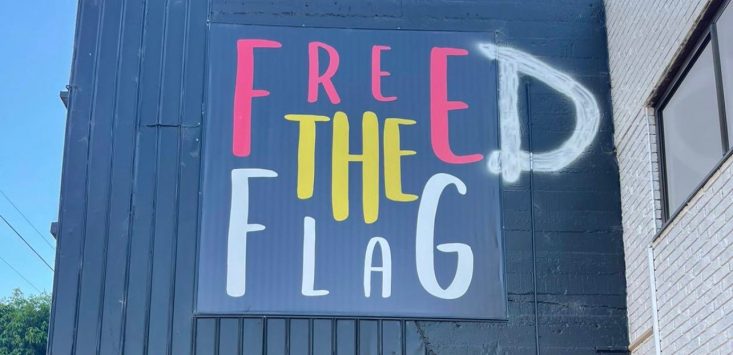
Clothing the Gaps redecorated their building to celebrate their campaign's conclusion. Twitter: Clothing The Gap
The Aboriginal flag “belongs to everyone, and no-one can take it away”, Indigenous Affairs Minister Ken Wyatt has proudly declared, after the federal government paid $20 million for the rights to the artwork.
But how did it come to this?
Luritja artist Harold Thomas created the flag way back in 1970 to lead a NAIDOC march.
That means, unlike country flags, the Aboriginal flag was privately owned by Thomas — he had the sole right to reproduce it and can give that right to others under what is known as licensing agreements.
It’s no different to a regular artwork — even though, crucially, the flag came to represent the entire First Nations Peoples.
Marque Lawyers principal Michael Bradley compared it to a landlord leasing their place: “The lessee gets an exclusive occupation right, but the owner retains the legal title,” he says.
Fast forward to 1995, and the flag was officially recognised as a national flag of Australia — two years later the Federal Court confirmed Thomas was the author and owner of the copyright.
Interestingly, Thomas also got the “moral rights”, Bradley explains, which are separate from the copyright.
“Moral rights include the right to be properly attributed when the work is reproduced, and the right to have a say in changes which might affect the integrity of the work (most commonly this is invoked in relation to architectural designs),” Bradley says.
How did the problems start?
A year later, in 1998, Thomas inked a deal with Flag World which saw them become the exclusive manufacturer of Aboriginal Flags and bunting.
This is all regular licencing stuff, Bradley says. “Exclusive rights can be attached to a licence instead, which can be limited in various ways … geographically or by type of use.”
In 2018, however, Thomas agreed to give a non-Indigenous company called WAM Clothing the exclusive clothing right, and this is where it gets really sticky.
Why would Thomas do this? Well — money, Bradley says.
Every time someone came to WAM Clothing with a request (and a cheque) to use the Aboriginal flag, Thomas was paid royalties.
But WAM Clothing’s co-founder Semele Moore took his clothing copyright pretty seriously — he sent cease-and-desist letters to both the AFL and NRL for using the flag during their Indigenous rounds.
It’s not known whether the peak football bodies didn’t negotiate with WAM Clothing — or whether the negotiations failed — but the flag disappeared from the AFL’s Indigenous Round centre ground in any case.
Then, an Indigenous-owned social enterprise known as Clothing The Gaps (which donates its profits to Indigenous health) received a cease and desist letter over their use of the flag.
Co-founder Laura Thompson was incensed, and the “Free the Flag” campaign was born.
So what just happened?
Yesterday, they won. The historic $20 million settlement between Thomas and the federal government confirmed last night will see the flag return to the public domain.
That means the black, yellow and red flag can be freely painted on sports grounds, used on apparel like as sports jerseys and shirts, on websites, in paintings and other artworks, digitally and in any other medium — all without permission or fees.
Flag World will continue to be the only producer of Aboriginal flags to ensure their quality and home-grown manufacturing, the federal government confirmed, but it’s only a commercial agreement, meaning people can make their own flag for personal use if they want.
OK — what’s next?
“The Aboriginal Flag will now be managed in a similar manner to the Australian National Flag,” Prime Minister Scott Morrison says. “Where its use is free, but must be presented in a respectful and dignified way.”
All royalties the government inherited from Thomas will be put into NAIDOC, and the government has also agreed to a $100,000 scholarship to get more Indigenous kids into governance and leadership.
Thomas is really happy with the end product.
“The Flag represents the timeless history of our land and our people’s time on it,” he says.
“It is an introspection and appreciation of who we are. It draws from the history of our ancestors, our land, and our identity and will honour these well into the future”.
And all without the vice grip of copyright — but Bradley says it wasn’t really a matter of outdated law.
“The commercial licensing was problematic since it ran counter to what people had been assuming, but that just flushed out the issue,” he says.
“The only sensible solution was what happened: for the government to step in and buy the copyright, placing it in permanent public ownership as a national asset.
“I’d call it fair all ’round.”
Handpicked for you

Australia has long been complicit in modern slavery. It’s time boards addressed these risks



COMMENTS
SmartCompany is committed to hosting lively discussions. Help us keep the conversation useful, interesting and welcoming. We aim to publish comments quickly in the interest of promoting robust conversation, but we’re a small team and we deploy filters to protect against legal risk. Occasionally your comment may be held up while it is being reviewed, but we’re working as fast as we can to keep the conversation rolling.
The SmartCompany comment section is members-only content. Please subscribe to leave a comment.
The SmartCompany comment section is members-only content. Please login to leave a comment.